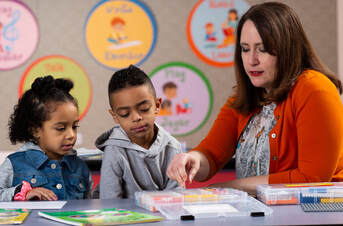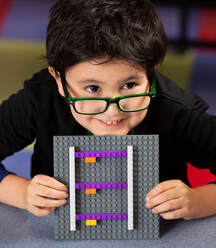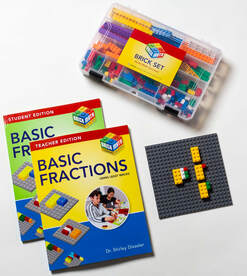 Journalist Jessica Grose has two recent op-eds in the New York Times that question the use of computers for children’s learning in subjects including mathematics. Students are using their school-issued Chromebooks and iPads to watch YouTube videos and play video games instead of following the teacher’s lesson. When kindergarteners learn to read only on iPads, not physical books, their comprehension suffers. Studies about technology-based education show that giving kids computers develops their computer proficiency, but not much else. Screens can help as practice tools, but they aren’t the best method for learning the basics of math and reading.  Our solution: Brick Math. The curriculum was developed as a screen-free method of learning. With Brick Math, students build models of math problems with plastic building bricks in thirteen K - 8th grade math content areas that range from Counting to Pre-Algebra. The students draw a model with bricks and explain with words why the model shows the math. The brick model makes the math tactile and concrete. For many students, the physical process of building with bricks is the key to learning when a traditional curriculum hasn’t worked for them.  Computers and screens may have their place in the classroom as “supports on the margins,” but their use seems limited. A screen-free program like Brick Math engages students fully and promotes true learning. Brick Math is a complete math curriculum for kindergarten through 8th grade that models the math with bricks. The curriculum is divided into 13 separate content areas: Counting, Addition, Subtraction, Multiplication, Division, Basic Fractions, Basic Measurement, Fraction Multiplication, Fraction Division, Advanced Measurement and Geometry, Decimals, Data and Statistics, and Pre-Algebra. Students can start anywhere in the curriculum. It can be used as a complete math curriculum or brought in as a supplement to help students who aren't having math success with other programs.  Brick Math works in many applications: for homeschooling, math intervention, enrichment, and as a whole-school program. Materials are simple and affordable. For an innovative way to teach and learn K - 8th grade math, check brickmath.com. The website includes videos for both teacher training and direct instruction of students. You can learn more about how Brick Math improves students' math test scores and hear what people who are using Brick Math have to say about the program.
0 Comments
 There are a number of recent research studies that assess the effects of online and hybrid learning during the past three pandemic-affected school years. The studies show that math scores have dropped considerably during this time, even more than reading. According to an Education Week article, students are 12 weeks behind where they should be in math – about four months, or one-third of a typical 36-week school year.  There is a lot of federal funding available for academic intervention and support to help kids catch up. Many experts recommend a multi-pronged approach to helping students get back on track: tutoring, after-school programs, summer school, and/or lengthening the school year.  Brick Math is a very effective curriculum for math intervention and support in grades K – 6. The program teaches basic math by modeling with LEGO bricks, so the process is tactile, easy to understand, and fun! Brick Math is designed to work in different settings: whole-class, small group, and one-on-one. It is simple to adopt in any of the support approaches a school chooses, as a tutoring curriculum, or part of an after-school or summer program.  Recommendations also include the need for schools to implement their intervention strategies as soon as possible, and the funding timeline will help reinforce a speedy plan: schools have only two years to spend the money allocated to help students catch up. That's another plus for Brick Math -- the brick modeling techniques are easy for teachers to learn. There are only a few materials needed: a lesson book for the teacher, a student workbook for each student, and a brick set for every one or two students using the program. As schools try to get back to "normal" this year, the Brick Math curriculum can help bring your students back where they should be in math.  Brick Math is a K-6 math curriculum that uses LEGO® bricks to model 11 different math subjects: Counting, Addition, Subtraction, Multiplication, Division, Basic Fractions, Basic Measurement, Fraction Multiplication, Fraction Division, Advanced Measurement and Geometry, and Decimals. It works for homeschooling, math intervention, enrichment, and as a whole-school program. Materials are simple and affordable. If you teach math or have a student at home who is learning K - 6th grade math, check brickmath.com. The website includes videos for both teacher training and direct instruction of students. You can learn more about how Brick Math improves students' math test scores and hear what people who are using Brick Math have to say about the program.  Studies show that up to 30 percent of people report moderate to high levels of math anxiety, according to author Malia Wollan in an article that appeared on March 27, 2022 in the New York Times. Children as young as 6 can show signs of anxiety about math. Many adults (parent and teachers) make the mistake of telling children they are bad (or good) at math, which can increase the child’s apprehension about math.  One of the reasons students become anxious about math is that math is taught in a high-pressure situation, often by teachers who are uneasy about their own math skills. The Brick Math program can help reduce students’ math anxiety. Students “see” the math by building models with LEGO® or LEGO-compatible bricks. They engage with the math by drawing solutions to math problems and by explaining the process they used in writing or orally. In this program, students use a wide variety of sensory skills that reinforce how to solve math problems.  Addition, subtraction, multiplication, division, and fractions come alive to students when they learn with LEGO® bricks. The New York Times article recommends, “When you work on calculations with children, try to do so with curiosity, playfulness and a sense of adventure.” When math becomes fun, the student’s anxiety level decreases. That’s the power of Brick Math. Brick Math is a K-6 math curriculum that uses LEGO® bricks to model 11 different math subjects: Counting, Addition, Subtraction, Multiplication, Division, Basic Fractions, Basic Measurement, Fraction Multiplication, Fraction Division, Advanced Measurement and Geometry, and Decimals. It works for homeschooling, math intervention, enrichment, and as a whole-school program. Materials are simple and affordable.
If you teach math or have a student at home who is learning K - 6th grade math, check brickmath.com. The website includes videos for both teacher training and direct instruction of students. You can learn more about how Brick Math improves students' math test scores and hear what people who are using Brick Math have to say about the program.  During the pandemic, the math skills of many elementary school students have dropped significantly. In the coming school year, educators are faced with the challenge of helping students both regain skills and learn new material. The latest thinking on how to help students who have lost math skills during the COVID year is to accelerate instruction rather than hold back. Guidance from the US Department of Education is to move ahead with grade-level math instruction, but include new strategies for learning where students show deficits.  Brick Math is the perfect solution for teachers and schools looking for a way to help students whose math skills have faltered in the past year. The K – 6th grade program uses LEGO bricks to model math, an innovative approach that helps students quickly learn mathematic basics that range from Counting through Advanced Geometry. Since the program is modular, it can be brought in to address specific learning deficits a student may have. For example, if a teacher finds that a student missed out on learning decimals last year, the Brick Math program of instruction for Decimals will help that student move back up to grade level work quickly.  Here’s how Brick Math can help a student who has lost math skills over the past year: 1. Determine what area of math the student is having trouble with (for example, understanding decimals). 2. Bring in the Brick Math subject area as needed (in the example, use the methods in the Decimals Teacher and Student books). The program focuses on helping the student quickly understand and master the topic. 3. Now the student is ready to rejoin the whole class in grade-level math. Brick Math is a K-6 math curriculum that uses LEGO® bricks to model 11 different math subjects: Counting, Addition, Subtraction, Multiplication, Division, Basic Fractions, Basic Measurement, Fraction Multiplication, Fraction Division, Advanced Measurement and Geometry, and Decimals. It works well for homeschooling, math intervention, enrichment, and as a whole-school program. Materials are simple and affordable.
If you teach math or have a student at home who is learning math, check brickmath.com. The website includes videos for both teacher training and direct instruction of students. You can learn more about how Brick Math improves student math test scores and hear what people who are using Brick Math have to say about the program.  Acclaimed science writer Annie Murphy Paul wrote about the tremendous value in solving problems using real, 3-D objects in the New York Times Sunday, June 13. It’s so applicable to Brick Math, we just had to quote a little of the article: “Three-dimensional space offers additional opportunities for offloading mental work and enhancing the brain’s powers. When we turn a problem to be solved into a physical object that we can interact with, we activate the robust spatial abilities that allow us to navigate through real-world landscapes. This suite of human strengths, honed over eons of evolution, is wasted when we sit still and think. “This holds true for a wide variety of problem types — including basic arithmetic, complex reasoning, planning and challenges that require creative insight. People who are permitted to manipulate concrete tokens representing elements of the problem to be solved bear less of a cognitive load and enjoy increased working memory. They learn more and are better able to transfer their learning to new situations. They are less likely to engage in symbol pushing, or moving numbers and words around in the absence of understanding. They are more motivated and engaged and experience less anxiety. They even arrive at correct answers more quickly.” [italics and boldface are ours]  This is the essence of the Brick Math method. Students model K – 6th grade math problems using LEGO bricks, and in doing so, they activate their brains and really learn what the math means. Imagine building this brick model of dividing 24 by 6:  The brick model demonstrates the concept of dividing a set of 24 into 4 sets of 6. Using the 3-D bricks to model the problem helps a student, in the words of writer Paul, "navigate through real-world landscapes." Students put this another way: "I can SEE the math!" Later, the teacher introduces the number sentence 24 ÷ 6 = 4 so students learn how to write the problem using numerals. This problem is from Division Using LEGO® Bricks. Brick Math methods are based on learning theory from a number of leading experts. The program has been tested on students and shown to improve how well they learn math. Brick Math is a K-6 math curriculum that uses LEGO® bricks to model 11 different math subjects: Counting, Addition, Subtraction, Multiplication, Division, Basic Fractions, Basic Measurement, Fraction Multiplication, Fraction Division, Advanced Measurement and Geometry, and Decimals. It works well for homeschooling, math intervention, enrichment, and as a whole-school program. Materials are simple and affordable.
If you teach math or have a student at home who is learning math, check brickmath.com. The website includes videos for both teacher training and direct instruction of students. You can learn more about how Brick Math improves student math test scores and hear what people who are using Brick Math have to say about the program.  We know that play is an important part of a child’s life. In fact, a number of eminent scholars from Jean Piaget to Maria Montessori are credited with originating the phrase, “Play is child’s work.” Kids gain so much knowledge about the world through their play activities. According to Susan MacKay, Director of Teaching and Learning for the Portland Children’s Museum, “Learning through play is about continuity; bringing together children’s spheres of life-home, school, and the wider world over time and through experiences.” Now more than ever, when children’s social and emotional stressors have risen to an all time high, learning through play is key. Learning tools that engage children and link to the world of play add to student motivation. Brick Math uses a well-known and beloved toy, LEGO® bricks, as a strategic tool for learning K-6th grade math. According to Harvard University research (2016), play in the child’s learning environment enriches content understanding and retention of the material. The combination of learning and play helps students develop a deep understanding of the “why” and “how” behind math when they learn with Brick Math. An important idea in learning today is known as “constructionism.” Students construct their knowledge using real experience with materials. When then build their own knowledge, they learn in a deep and lasting way. Constructionism is at the heart of the Brick Math method. Students learn math by building models, discussing why they show the math, and drawing the brick models. It’s a powerful way to putting play back into learning content. Learning math with simple activities through play is one of the best ways for children to naturally develop a love for the subject. Brick Math combines learning with play to result in building a strong math foundation throughout the elementary years. We'd like to get feedback about Brick Math from people who have tried the curriculum. If you're a teacher, administrator, or parent who has used Brick Math with a student, please take a few moments to complete our short survey.
Thanks for your help!  New research shows that Brick Math: Teaching Math Using LEGO® Bricks is very successful as an elementary math teaching tool. Two important findings emerged from this study: 1. Students make dramatic improvements in test scores 2. Students are highly engaged with the Brick Math method of learning The research confirms that when students are engaged with the material, they are more likely to learn it fully. And students are fully engaged with the hands-on Brick Math program. Here's what the study showed: 1,400 K-5 students in North Carolina and New Jersey were taught using Brick Math in these six content areas:
The results: Brick Math engages students fully, and it achieves powerful learning growth! Click here to read more about the results of studies of the Brick Math curriculum.  A new mixed-method study shows significant gains in test scores for math content in grades K - 2 after instruction using Brick Math. The findings from a new study of 500 students in kindergarten, first grade, and second grade shows that 320 of the 500 students, or 64 percent, made pre-to-post assessment gains of 4 or more points on a 10-point scale. Each student was given ten problems to complete, in writing or orally, in the areas of counting and cardinality, addition, or subtraction prior to being taught with the Brick Math methods. The same problems were then used with the Brick Math program. Before starting Brick Math, students were asked questions about why they responded in certain ways to the problems to help the researcher identify misconceptions held by students about number sense and computational understanding. Once the problems were completed using the Brick Math methods, the problems were again scored on a scale of 1 - 10 (correct versus incorrect). Students were then asked to discuss the meaning of the models with the researcher. Students were also encouraged to ask questions for clarity during the teaching process. The discussion of the models yielded some important information about how students learn and understand math. Students in kindergarten made comments such as: “Now I see why 8 is larger than 3,” and "5 is between 3 and 8.” Students learning about place value said, “Counting bricks in the tens and ones place helps me know what number goes in each place.” A student further explained, “Two 1x2 bricks and four 1x1 bricks show that the tens place is 2 and the ones place is 4, and the whole number is 24.” Participants: This study was conducted in public and private school classrooms in New Jersey and North Carolina, in rural, suburban, and urban settings for 150 kindergarten, 200 first grade, and 200 second grade students. Data and Findings: The data was analyzed using a one-way ANOVA from SPSS, which indicates that achievement was statistically significant across all three grade levels and all content materials. A Pearson correlation shows no significance between the performance of girls versus boys. This finding is interesting, in that many believe LEGO® bricks are preferred by boys. In this study, the girls did as well as the boys in achievement when using Brick Math. The variables measured in the study included: focus and body language when using Brick Math, verbal participation and questioning by the student, the degree to which students were able to make conceptual meanings in the models, performance pre to post (before Brick Math instruction and after Brick Math instruction). It was interesting to note that the degree of focus was significant (p = 0.03) upon introduction of the bricks to do the math problems. The findings also suggest that both the level of performance and the degree of perseverance are directly related to the degree to which the student could focus (p < .05) in all correlations of these variables. The median pre- to post-difference in the study across all groups was 4 with a range from 0 – 10. The means are displayed for each grade, pre and post, in Table 1. The spread of the mean shows wide differences before and after the instruction in each of the three grades, with the largest difference found in grade 2. Table 1: Comparison of Means Pre-to-Post by Grade Level Grade N Means Pre Post K 150 3.3600 7.2667 1 150 4.0467 7.6133 2 200 3.6050 8.0300 Discussion: The modeling of math offers students a way to connect, but when LEGO® bricks are introduced as the medium for learning content, students become enthusiastic, focused, and engaged, which leads to motivation and time on task. Education experts agree that motivation and engagement are the two key elements in getting students to learn. This study is part of a larger study being conducted to emphasize the value of Brick Math in elementary and middle school math classrooms. This study, which utilized Brick Math as both a guided math and whole class lesson, points to positive learning gains for children in the early years of elementary math. Setting the stage for more sophisticated math content, getting students to understand the “why” behind the basics of math is a key component necessary in early stages of math learning. If students can build a model of the problem and solution, and explain verbally or in writing the “why” behind the math, the likelihood of future success in both their opinions about math and their ability to persevere in dealing with more difficult math will be greatly enhanced. by Dr. Shirley Disseler
According to 2017 research by the LEGO Foundation, using LEGO bricks ignites four key types of processing and 24 key skills in the brain that lead to great retention of information. The four types of processing are:
Modeling and building with bricks to learn math helps with children’s self-regulation skills. These enhance the skills of emotional regulation and attachment to content, long-term memory, attention, mental imagery, and system thinking. During the process of self-regulation, the brain places a “file folder” for that model in the long-term memory of the brain. Using bricks when learning math helps develop the child’s executive function, which is tied to the skills of visual perception, initiation, adaptive social functioning (collaboration), and one’s ability to self-assess. Being able to actually see the steps in a math problem by modeling it with bricks is a great way to visualize what the math means and why it works. Learning math using bricks also develops the process of symbolic representation, which directly leads to the skills of kinesthetic awareness, spatial visualization, sensory-motor abilities, mental rotation, and working memory. When you learn math, you identify numbers and spaces by visualizing what they represent or by using mental math. The process of building with bricks places the focus on the eyes and the hands, which lead to cognitive understanding and the ability to visual a number or a space. The last of the four processes enhanced by building with bricks is spatial ability. This process provides a greater short-term memory, fine motor skills, and increased cognitive flexibility. In math, the ability to utilize invented strategies, think logically, and use reason to determine solutions is all part of cognitive flexibility. Building brick models enhances fine motor skills by providing a tactile experience. It looks like the brick is the brain’s new best friend! It helps kids attend, engage, and focus on learning through building brick models with their hands. |
Categories
All
Archives
July 2024
|




